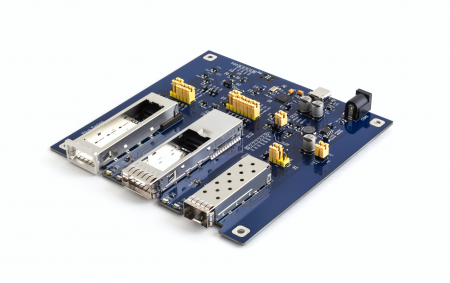SFPTotal Plus X
Application
Programmers SFPTotal are used to solve next tasks:
- Programming transceviers SFP, XFP, QSFP and QSFP-DD form factors
- Providing of compatibility between network equipment of different manufacturers
- Reflashing memory of write-protected transceivers
- Changing settings of PHY controllers
- Branding for OEM transceivers
- Diagnosis transceiver by reading the DDM
- Accounting for optical transceivers
Quick start guide
- Connect SFPTotal Plus board to your PC using USB type C cable
- Install drivers for SFPTotal Device
- Download application SFPTotal Wizard
- Start SFPTotal Wizard
- Insert transceiver to the programmer port
- Reading transceiver's memory
Listing of elements
Listing of elements placed on circuit board of SFPTotal Plus X programmer
1. Transceiver ports
P2 - Port for SFP, SFP+, SFP28 transceivers
P11 - Port for QSFP+, QSFP28 and QSFP-DD
P9 - Port for XFP
2. Power supply plans
P26 - Common power supply 3.3V for ports. Must be connected to provide power supply on ports.
P1 - PWR_TX and PWR_RX connectors are power supply of SFP port, a pair of 3.3 V for VccT and VccR pins.
P24, P23, P17, P16, P15, P8 - power supply of QSFP-DD port, 3.3 V for Vcc1, VccTx and VccRx pins.
P12, P14, P13, P10 - power supply of XFP port: 3.3V, -5V, 5V and 1.8 power supply plans.
3. Jumpers
P3 - low power mode, keep closed to disable low power mode (TX enable).
P4 - RS1 (position 1-2) and RS0 (position 3-4) pins.
P18 - QSFP ModSelL
The ModSelL is an input pin. When held low by the host, the module responds to 2-wire serial communication commands. The ModSelL allows the use of multiple QSFP modules on a single 2-wire interface bus. When the ModSelL is “High”, the module shall not respond to or acknowledge any 2-wire interface communication from the host. ModSelL signal input node must be biased to the “High” state in the module. INF-8438
Notice: The programmer automatically switches the contact to "Low" level when performing read and write operations on the data bus.
P19 - QSFP ResetL
P20 - XFP ModDeSel
The Mod_DeSel is an input pin. When held Low by the host, the module responds to 2-wire serial communication commands. The Mod_DeSel allows the use of multiple XFP modules on a single 2-wire interface bus. When the Mod_DeSel pin is “High”, the module shall not respond to or acknowledge any 2-wire interface communication from the host. Mod_DeSel pin must be pulled to VCC3 in the module. INF-8077i
Notice: The programmer automatically switches the contact to "Low" level when performing read and write operations on the data bus.
P21 - XFP PDOWN/RESET
This is a multifunction pin for module Power Down and Reset. The P_Down/RST pin must be pulled up to VCC3 in the XFP module. INF-8077i
4. Interfaces
P5 - USB type C port for connection to PC
P22 - I2C databus with logic level 3V3 and 5V
5. LED indicators
LED1 - POWER - should statically light when board connected to USB or to external supply adapter.
LED2 - MCU - indication of power supply for microcontroller.
LED3 - ERROR - should glow when unhandled errors occur on the data bus, for example: connection more than 1 transceiver.
LED4 - STATUS - should blinking when transceiver is not connected and statically light when transceiver is connected.
Management interface
The device provides access to management interface (CLI) by connecting through a virtual serial port. You can use the programming board without SFPTotal Wizard software to get more features or to realize the opportunities that are not available in the standard software. Use this document to get information about commands which supported by SFPTotal Plus.
Management inerface is full compatible with SFPTotal Plus https://wiki.sfptotal.com/index.php/SFPTotal_Plus#Management_interface
